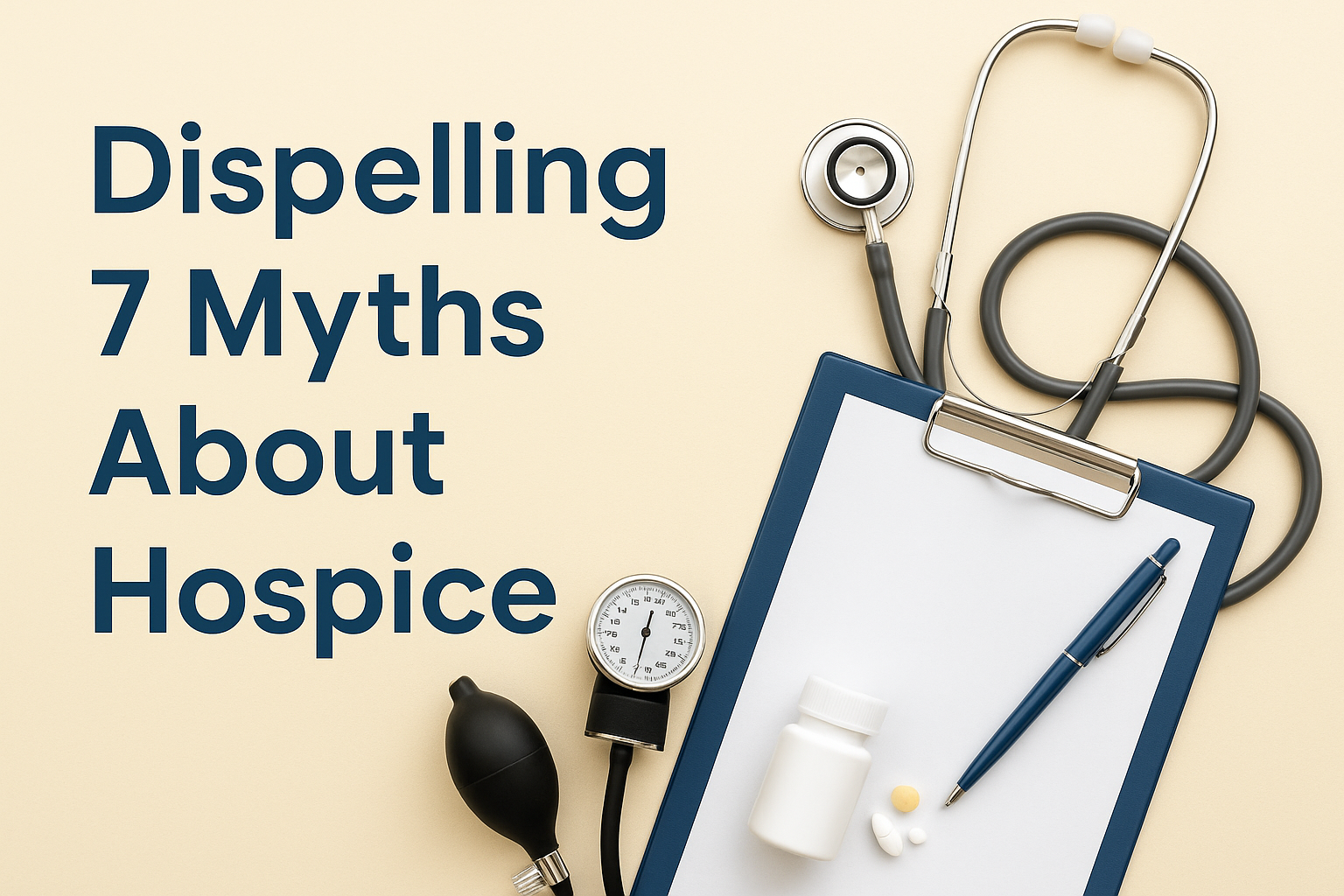If someone you love has just been referred to or admitted into hospice, you probably have a lot of questions and maybe even a few fears. That’s completely normal. Hospice is one of the most misunderstood parts of healthcare, and a lot of the things people think they know about it just aren’t true.
Let’s take a few minutes to clear up some of the most common myths so you can feel more confident about what hospice is (and isn’t).
Myth #1: Hospice means we’re giving up.
The truth: Hospice isn’t about giving up. It’s about focusing on comfort and quality of life. When the goal changes from curing to comfort, hospice helps people live as fully and comfortably as they can. That includes expert pain management, emotional and spiritual support, and help for families too. Many people say their loved one felt more cared for and supported after starting hospice.
A 2007 study published in The Journal of Pain and Symptom Management found that hospice patients often had a higher quality of life and even lived longer than those who did not receive hospice care (Connor et al., 2007).
Myth #2: Hospice is only for the last few days of life.
The truth: Hospice is actually meant for the last six months of life - or longer. While some people start hospice in the final days, it’s often more helpful to start earlier. That gives the care team more time to manage symptoms, prevent unnecessary hospital visits, and support both the patient and the family. The earlier hospice begins, the more it can help.
According to the National Hospice and Palliative Care Organization (NHPCO), the median length of stay in hospice was just 17 days in 2020. However, those who received care longer reported greater comfort and support (NHPCO Facts & Figures, 2022).
Myth #3: Hospice means going to a special facility.
The truth: The majority of hospice care is provided in the place the patient calls home - whether that’s a private home, assisted living, or a nursing facility. A hospice team comes to you, bringing medical support, supplies, and guidance so your loved one can stay in a familiar and comfortable environment.
NHPCO data confirms that over 98% of hospice care is provided in the community, with 53.8% at home and another 32.5% in nursing facilities or assisted living communities (NHPCO, 2022).
Myth #4: Hospice is only for people with cancer.
The truth: Hospice is for anyone with a serious, life-limiting illness. Today, hospice supports people with many conditions, like heart disease, dementia, lung disease, stroke, ALS, kidney failure, and more. If a doctor believes someone has six months or less to live and the focus is shifting to comfort and quality of life, they may be eligible for hospice.
Myth #5: Hospice stops all treatments.
The truth: Hospice continues treatments that bring comfort. You won’t see aggressive, cure-focused treatments, but patients still receive medications and care to ease pain, anxiety, shortness of breath, and more. In some cases, therapies like oxygen, antibiotics, or physical therapy may still be included, if they help improve comfort and quality of life.
The Centers for Medicare & Medicaid Services (CMS) outlines that hospice includes a broad scope of services—from nursing and physician support to counseling and medical equipment (CMS Hospice Center).
Myth #6: Hospice is expensive.
The truth: Hospice care is often more affordable than people think. Hospice may be covered 100% by Medicare, Medicaid, and many private insurers. By choosing a Medicare-approved hospice provider, Medicare benefits cover hospice-related costs, including medications, equipment, nurse visits, social work support, and grief counseling (Medicare.gov Hospice Costs). If you are using private insurance plans, verify their hospice benefits. Families often pay little to nothing out of pocket, making hospice both compassionate and financially accessible.
Myth #7: Hospice only supports the patient.
The truth: Hospice supports the whole family, not just the person who is ill. Caregivers often carry a heavy load, emotionally and physically. Hospice provides practical help, emotional support, spiritual care, and grief counseling - for both the patient and their loved ones. After someone passes, many hospice teams continue to offer bereavement support for over a year.
A Final Thought
Choosing hospice isn’t giving up hope. It’s just a different kind of hope - the kind that focuses on peace, connection, and comfort in the time you have together. Hospice also supports you as a caregiver, giving you guidance, respite, and someone to lean on.
If you’re wondering whether hospice is right for your family, you’re not alone. There are people ready to help you make sense of it all, without any pressure.
Sources
- Connor, S. R., Pyenson, B., Fitch, K., Spence, C., & Iwasaki, K. (2007). Comparing hospice and non-hospice patient survival among patients who die within a three-year window. Journal of Pain and Symptom Management, 33(3), 238–246. https://www.jpsmjournal.com/article/S0885-3924(07)00323-9/fulltext
- National Hospice and Palliative Care Organization (NHPCO). (2022). NHPCO Facts and Figures: Hospice Care in America. https://www.nhpco.org/wp-content/uploads/NHPCO-Facts-Figures-2022.pdf
- Centers for Medicare & Medicaid Services (CMS). Hospice Center. https://www.cms.gov/Medicare/Medicare-Fee-for-Service-Payment/Hospice
- Medicare.gov. Hospice Care Coverage. https://www.medicare.gov/coverage/hospice-care



.jpg)
.jpg)
.jpg)